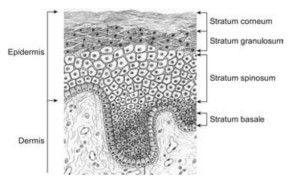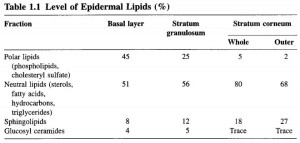(Info and image source: Handbook of Cosmetic Science and Technology)
Lipids of the skin layers:
- In the lower layers of the epidermis: Cholesterol, triglycerides, and phospholipids
- In the stratum spinosum and stratum granulsosum: phospholipids, glycolipids, and free sterols.
- In the stratum corneum: ceramides, free sterols, and free fatty acids.
Stratum corneum lipids play a major role in maintaining skin hydration. These intercellular lipids comprise approximately 40% to 50% ceramides, 20% to 25% cholesterol, 15% to 25% fatty acids (that have chain lengths between 16 and 30 carbons, C24:0–C28:0 being the most abundant), and 5% to 10% cholesterol sulfate.
These lipids are arranged in a highly organized stacked bilayers (lamellar arrangement) surrounding the corneocytes in the stratum corneum with very small amounts of water present.
The lipids are derived from the degradation of cells in the granular layer of skin. Special lipid structures called lamellar granules are released into the extracellular spaces of the degrading cells. There is also release of lipids from the former cell membranes. These released lipids include cholesterol, free fatty acids and sphingolipids.
Ceramide, a type of sphingolipid derived from the lamellar granules, is one of the major lipid components responsible for generating the stacked lipid structures. These lipids trap water molecules in their hydrophilic (water attracting) region. There are about nine major ceramides, which are synthesized from glucosylceramides, epidermosides (acylglucosylceramides), and sphingomyelin. These ceramides have complex structures varying in both their polar head groups and dual hydrophobic chains.
The newly formed stacked lipids surrounding the corneocytes provide an impermeable barrier for the passage of water out of the stratum corneum and the prevention of the natural moisturizing factors from leaching out of the surface layers of skin.
The intercellular lipids and corneocytes containing proteins and natural moisturizing factors work together to provide an efficient barrier against water loss and water retention to maintain the flexibility of the skin.
In the skin, there is a relatively large gradient in water chemical potential between the viable epidermis, where the water content is about 70% by weight, and the stratum granulosum/stratum corneum junction, where the water content drops to 15% to 30%. Under this large water gradient, the stacked bilayer arrangement of lipids, which is a continuous region in the stratum corneum, provides an optimal way to reduce water loss through the skin. Water escaping from the stratum corneum would have to traverse the tortuous pathway of the bilayer. In addition, fully matured corneocytes would also increase the tortuosity and hence the diffusional path length of water. The combination of a lamellar arrangement of lipids and increased diffusional path length due to corneocytes reduce water diffusion to the atmosphere
This compact lamellar structure is a very effective barrier to the transepidermal water loss (TEWL) and environmental assaults.

